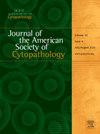Optimizing tissue adequacy for next-generation sequencing in small biopsies and fine-needle aspirations for nonsmall cell lung cancer: a root cause analysis and proposed solutions
Q2 Medicine
Journal of the American Society of Cytopathology
Pub Date : 2025-03-28
DOI:10.1016/j.jasc.2025.03.005
引用次数: 0
Abstract
Introduction
Molecular testing is essential for managing advanced nonsmall cell lung cancer, yet up to 40% of biopsies can be inadequate due to insufficient tissue. This study aimed to identify causes of inadequate sampling through fine needle aspiration (FNA) and core needle biopsy (CNB) and propose solutions.
Materials and methods
We analyzed 96 patients undergoing endobronchial ultrasound (EBUS)-guided FNA or CNB for nonsmall cell lung cancer, alongside 44 patients with CT-guided CNB. All patients were tested using the MayoComplete Solid Tumor Panel, a comprehensive next-generation sequencing assay. A root cause analysis identified factors affecting tissue adequacy, such as needle size, pass numbers, and specimen types.
Results
Among EBUS biopsies, 35.3% of cases with FNA smears were inadequate, compared to 20% for CNB alone. The combination of both smears and tissue cores had the highest adequacy rate, with only 11.4% inadequacy for next-generation sequencing. We investigated the discrepancy between lymph nodes and lung tissue by examining nonpulmonary lymph nodes, liver, and soft tissue biopsies. Lymph node CNB had a 30% inadequacy rate, while liver and soft tissue showed 14.3% and 15.4%, indicating that lymph node heterogeneity may affect tissue adequacy. For CT-guided CNB, cases with 5 or more passes showed 85% adequacy, increasing to 100% with over 7 passes.
Conclusions
Combining CNB with EBUS FNA improves sample adequacy, especially for lymph nodes. We recommend these approaches to optimize tissue yield for molecular testing, aiding timely therapy initiation and reducing repeat biopsies. Smaller gene panels may also be useful when tissue is limited.
优化非小细胞肺癌小活检和细针穿刺的下一代测序组织充分性:根本原因分析和建议的解决方案。
分子检测对于治疗晚期非小细胞肺癌至关重要,但由于组织不足,高达40%的活检可能不充分。本研究旨在通过细针抽吸(FNA)和核心针活检(CNB)找出取样不足的原因,并提出解决方案。材料和方法:我们分析了96例接受支气管内超声(EBUS)引导的非小细胞肺癌FNA或CNB的患者,以及44例ct引导的CNB患者。所有患者均采用MayoComplete实体瘤检测,这是一种全面的下一代测序检测方法。根本原因分析确定了影响组织充分性的因素,如针头大小、通过次数和标本类型。结果:在EBUS活检中,35.3%的病例FNA涂片不充分,而单独CNB的这一比例为20%。涂片和组织核的组合有最高的充分率,只有11.4%的不充分率。我们通过检查非肺淋巴结、肝脏和软组织活检来研究淋巴结和肺组织之间的差异。淋巴结CNB的不充分率为30%,而肝脏和软组织的不充分率分别为14.3%和15.4%,说明淋巴结异质性可能影响组织充分性。对于ct引导下的CNB,通过5次及以上的病例充分性为85%,通过7次以上的病例充分性为100%。结论:CNB联合EBUS FNA可提高样本充分性,尤其是淋巴结。我们推荐这些方法来优化分子检测的组织产量,帮助及时开始治疗并减少重复活检。当组织有限时,较小的基因面板也可能有用。
本文章由计算机程序翻译,如有差异,请以英文原文为准。
求助全文
约1分钟内获得全文
求助全文
来源期刊

Journal of the American Society of Cytopathology
Medicine-Pathology and Forensic Medicine
CiteScore
4.30
自引率
0.00%
发文量
226
审稿时长
40 days
 求助内容:
求助内容: 应助结果提醒方式:
应助结果提醒方式:


